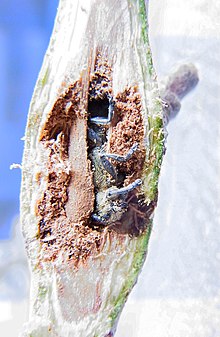Small poplar buck
| Small poplar buck | ||||||||||||
|---|---|---|---|---|---|---|---|---|---|---|---|---|

Little Poplar Bock ( Saperda populnea ) |
||||||||||||
| Systematics | ||||||||||||
|
||||||||||||
| Scientific name | ||||||||||||
| Saperda populnea | ||||||||||||
| ( Linnaeus , 1758) |
The Small Pappelbock , aspen stand or Small Aspen Bock ( Saperda populnea ) is a beetle from the family of longhorn beetles (Cerambycidae). The species occasionally occurs as a pest on young poplars.
description
The beetles are 9 to 15 millimeters long. Their body has a black base color and is yellow, rarely whitish tomentose . At the top is a yellow Augensaum and two for pronotum divergent apex bands. Three yellow longitudinal bands run along the pronotum; two on the side and one in the middle. It is as long as it is wide. The upper wings each have five distinctive yellow spots and are roughly structured as points. They are narrowly rounded at the end. The number and extent of the spots can vary. The antennae are colored whitish from the third link on the lower two thirds of each segment, otherwise black. The antennae of the males are almost as long as their body, in the females they are shorter.
Occurrence and habitat
The species is distributed in the Palearctic and occurs in the north to central Norway and the north of Sweden and Finland. It is widespread locally in England. The beetles colonize forest edges, pioneer trees, field hedges and forest and field paths with poplar vegetation and occur from the flatlands to low mountain ranges, in the south also in higher mountain ranges.
Way of life
The animals appear from May to July. They are found on thin branches and leaves of aspen ( Populus tremula ) and other poplars , and more rarely also on Sal willows ( Salix caprea ). The females make a round egg hole in a living branch before laying their eggs, first biting several flat cracks. Then the egg hole is bordered with a horseshoe-shaped furrow. A single egg is deposited in the egg hole. The larva initially feeds on the juicy and proliferating plant tissue that has been irritated by the damage and later eats its way deeper into the marrow. The presence of the larvae can be seen on the branches through plant galls. Development takes two years and pupation takes place inside the branch. The adults slip through a circular hole.
supporting documents
literature
- Georg Möller, Reiner Grube, Ekkehard Wachmann : The Fauna Käferführer I - Beetles in and on the forest Fauna-Verlag, Nottuln 2006, ISBN 3-935980-25-6 .
- Jiři Zahradnik, Irmgard Jung, Dieter Jung et al .: Beetles of Central and Northwestern Europe. Parey, Berlin 1985, ISBN 3-490-27118-1 .
Web links
- Saperda populnea at Fauna Europaea
